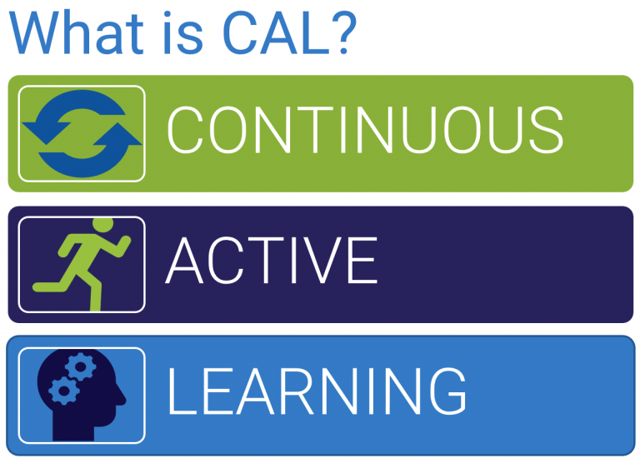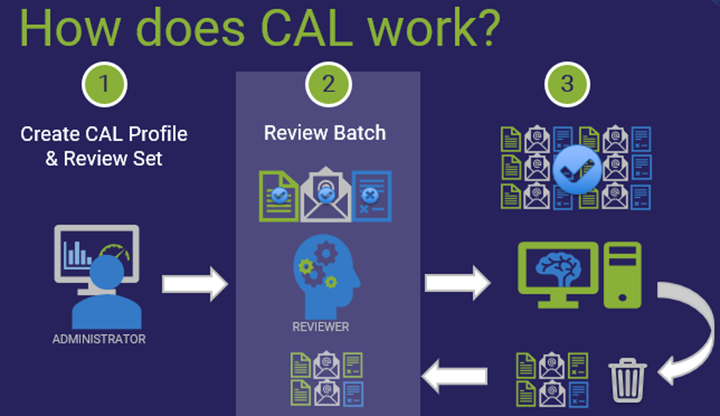Do you need an eDiscovery Software tool to help with accuracy and speed up the review of the increasingly larger datasets in your legal cases? If so, VenioOne continuous active learning, or VenioOne CAL, may be just what you need.

What is VenioOne CAL?
VenioOne CAL is a module of VenioOne that leverages machine learning to speed up the eDiscovery review process. VenioOne CAL uses human reviewers combined with machine learning to boost the speed of eDiscovery document reviews, yielding better results faster.
Continuous: The model changes continuously, because VenioOne CAL uses dynamic vs. static training models.
Active: VenioOne actively responds to actions taken by reviewers and adjusts the batches presented to them.
Learning: Machine learning is leveraged to both improve the model and double check reviewers.
Unlike traditional technology assisted review (TAR) where humans had to spend a lot of time training and refining a static model, VenioOne CAL creates the model automatically as reviewers review and check in batches of documents. This eliminates the time required for humans to perfect a training model. There is no seed set, so there is no trial and error trying to get the training model just right. VenioOne CAL does all of that on the back end. That means there are no worries about how much training is enough and review can begin immediately. Therefore, review and training become one process.
This is possible, because the VenioOne CAL training model is continuously updated not based on a stagnant seed set, but based on the reviewer’s coding decisions. Additionally, unlike TAR, VenioOne CAL’s training model is dynamic and updates as new data is added to a dataset. With less effort, you will rapidly surface more relevant documents, which means faster results and lower costs. Who doesn’t want that?
How does VenioOne CAL work with our eDiscovery Software Tool?
As with any review set, the Administrator establishes review categories (tags) as part of the VenioOne CAL profile. In addition, the administrator designates a primary VenioOne CAL category and sets batch richness and relevance thresholds for VenioOne CAL to meet. These thresholds determine when the human review will end.
With VenioOne CAL, there is no training to be done by subject matter experts (SMEs), so reviewers immediately begin reviewing the batches of documents that VenioOne CAL presents.

What happens behind the scenes?
As batches are reviewed and each one is checked in, VenioOne CAL is:
- Dynamically evaluating the review set
- Scoring documents
- Recalibrating the model
- Re-ranking documents
- Tracking the Batch Richness and Relevance Thresholds
This is done in order to present more relevant documents to the reviewers as the review progresses and so that VenioOne CAL knows when to stop presenting batches to them. When VenioOne CAL determines it is able to predict the remaining documents based on the batches coded by the reviewers, then it will notify the reviewers that there are no additional batches available. The project administrator and subject matter experts are then able to perform whatever quality control checks they determine are necessary.
Staying on Target
With any technology as with humans, there is the risk of error. With predictive technology, the risk is getting a homogeneous set of data. Venio’s version of CAL is designed for “contextual diversity” in the documents presented to the reviewers. It does this by constantly scoring and re-ranking documents as batches are checked in by the reviewers. It presents a mixture of documents to the reviewers that includes low scoring documents. This serves as a check and balance of not only the performance of the system, but also the reviewers.
VenioOne CAL uses “auto” tags for the items it predicts, and human reviewers use “manual” tags for the items they review. Therefore, it is very easy to search by these tags and see where discrepancies may be between the documents that have been reviewed versus predicted by VenioOne CAL. These tags can be applied outside of the model and will be included in the re-ranking as additional batches are checked in by reviewers.
As you would expect, VenioOne also has a robust dashboard and reporting for tracking reviewer progress and VenioOne CAL’s performance throughout the process.
Immediate ROI
The beauty of VenioOne CAL is that you will see a return on your investment in no time at all. First, with VenioOne CAL doing the heavy lifting, you may be able to review as little as 10% of your dataset. That’s an immediate saving of time and money.
Second, with your SMEs not having to work on perfecting training models, they are freed up to perform more high value tasks. SMEs can focus on how best to surface relevant documents by performing keyword searches and doing deeper analysis of the data. They will also have more time to monitor the review team: doing QC, helping reviewers in areas that may be ambiguous or unclear, or getting low performing reviewers up to speed.
Given the ever-increasing amounts of electronic data to be reviewed in legal matters, it is becoming untenable, both physically and financially, to gather enough people to review documents quickly enough to keep cases moving forward. Therefore, eDiscovery Software Tool professionals must begin utilizing technology advancements such as CAL to keep up.
If you are intrigued and would like to see VenioOne CAL in action, you may view the webinar recordings below or contact sales@veniosystems.com for a demo or testing the VenioOne CAL capability.
Resources
Webinar 1: We are Introducing CAL, Are you Ready?
Webinar 2: What you need to know about CAL.